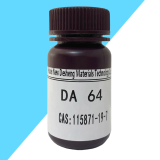Chinese VersionChina Suppliers > Hubei new DE sheng material science and technology co., LTD. > Introduction to chromogenic substrate DA64
- Search Product
-
-
- Region :China/Hubei
- Tel : +86-18971041571
- Fax :
- Email :vickyzhao@whdschem.com
- URL :
- Add :Guanggu United Science and Technology City C8, Ezhou City, Hubei Province
- Details for Introduction to chromogenic substrate DA64
-
Introduction to chromogenic substrate DA64
Category : Other Chemicals/Others

CAS NO : 115871-19-7 EC NO : MF : MW : Specification : White Powder Packing : 10g/bottle Product description : Physical and chemical properties of DA64 The chromogen substrate DA64 has more advantages in the detection system of peroxidase, with molecular formula C19H23N4NaO3, molecular weight 378.39, full name N - (carboxymethyl amino carbonyl) -4,4 '- bis (dimethylamino) diphenylamine sodium, appearance white to green brown or gray green, crystalline powder to powder. Every 100g of water can dissolve 40mg of DA64, dissolved in water at a concentration of 1 mM or more. The advantages of DA64 From a molecular structure perspective, DA64 is similar to Trinder's reagent or TMB, both containing aniline structures. After POD catalytic oxidation, it can generate color products with specific absorption wavelengths. The maximum absorption wavelength of DA64 λ Max (color rendering wavelength)=727 nm, ε/ H2O2 (extinction coefficient of one H2O2 molecule)=9 × 104. Most chromogenic substrates have wavelengths in the range of 400 to 550, while DA64 is as high as 727 nanometers, much higher than MAOS known for its long chromogenic wavelength (630nm). It has stronger anti-interference ability for complex samples and higher sensitivity for trace detection. Uses : chromogenic substrate Synonyms : N-[[bis[4-(dimethylamino)phenyl]amino]carbonyl]glycine sodium salt;
- more>>Other Products
-
- • Biological buffer 3- [N, N-di (hydroxyethyl) amino] -2-hydroxypropanesulfonic acid DIPSO
- • Luminol Sodium Salt
- • 4-Aminophthalhydrazide
- • acridinium ester DMAE-NHS
- • acridinium ester NSP-DMAE-NHS
- • Acridine hydrochloride NSP-SA
- • Acridine hydrochloride NSP-SA-NHS
- • NSP-SA-ADH
- • acridinium ester ME-DMAE-NHS TOOS; 3-(N-Ethyl-3-Methylanilino)-2-Hydroxypropanesulfonic Acid Sodium Salt
- • TOPS; Sodium 3-(N-Ethyl-3-Methylanilino)Propanesulfonate; N-Ethyl-N-Sulfopropyl-M-Toluidine Sodium Salt
- • ADOS Sodium 3-(Ethyl(3-Methoxyphenyl)Amino)-2-Hydroxypropane-1-Sulfonate Dihydrate
- • ADPS N-Ethyl-N-(3-Sulfopropyl)-3-Methoxyaniline Sodium Salt
- • ALPS N-Ethyl-N-(3-Sulfopropyl)Aniline Sodium Salt; Sodium 3-(Ethyl(Phenyl)Amino)Propane-1-Sulfonate; Sodium
- • DAOS; Sodium 3-((3,5-Dimethoxyphenyl)(Ethyl)Amino)-2-Hydroxypropane-1-Sulfonate
- • HDAOS; N-(2-Hydroxy-3-Sulfopropyl)-3,5-Dimethoxyaniline Sodium Salt
- • MADB N,N-Bis(4-Sulfobutyl)-3,5-Dimethylaniline Disodium Salt
- • MAOS N-Ethyl-N-(2-Hydroxy-3-Sulfopropyl)-3,5-Dimethylaniline Sodium Salt Monohydrate
- • DAB 3,3',4,4'-Biphenyltetramine Tetrahydrochloride